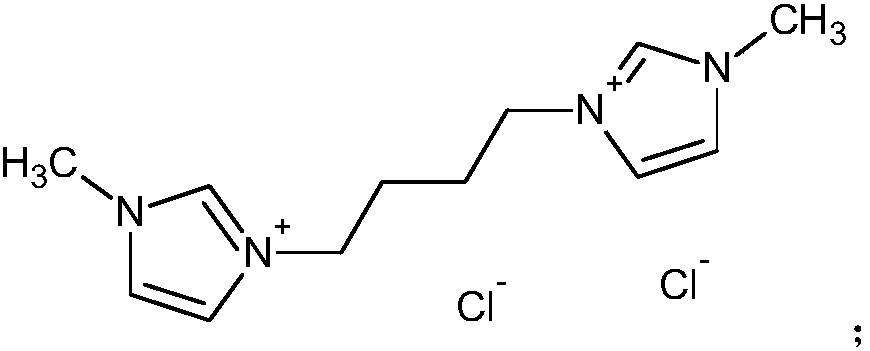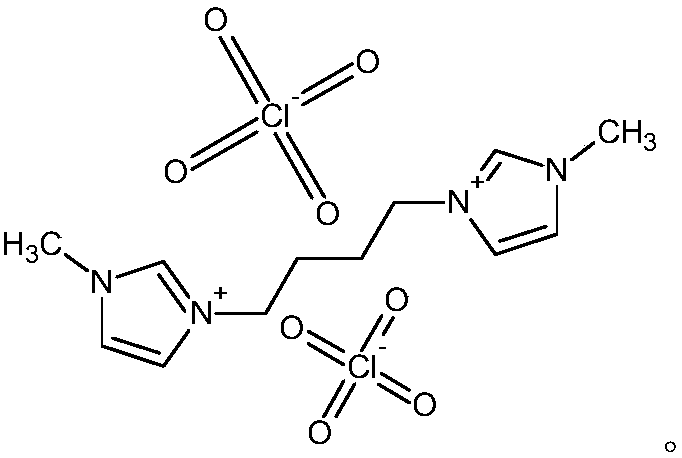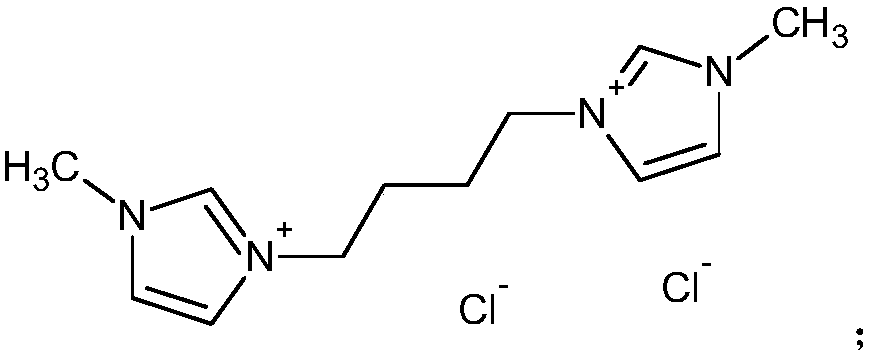Preparation method for cellulose graphene composite filament yarn
A graphene composite, cellulose technology, applied in the manufacture of artificial filaments, conductive/antistatic filaments in cellulose solution, etc., can solve the problem of long, usually 2-48 hours, even up to 120 hours, limited function The application and development of sexual fibers, the pressure resistance of spinnerets and the effect of drafting, etc., achieve the effects of excellent antistatic properties, good bonding firmness, and excellent antibacterial properties.
- Summary
- Abstract
- Description
- Claims
- Application Information
AI Technical Summary
Benefits of technology
Problems solved by technology
Method used
Image
Examples
Embodiment 1
[0050] 1. Preparation of 1,4-bis[1-(3-methylimidazolium)]butyl dichloride:
[0051] Under nitrogen protection at 80°C, slowly drop 1.2mol N-methylimidazole into 1mol 1,4-dichlorobutane, after the dropwise addition, reflux for 72 hours to complete the reaction, and cool the reaction solution to room temperature to obtain The product was washed with ether to remove unreacted raw materials, and a white solid was obtained, which was bis-1,4-bis[1-(3-methylimidazole)]butyl dichloride (HPLC purity was 98.8%, yield 88 %).
[0052] Two, the preparation of 1,4-bis[1-(3-methylimidazole)]butyl diperchlorate:
[0053] Dissolve 1 mol of 1,4-bis[1-(3-methylimidazolium)]butyl dichloride and 1.2 mol of lithium perchlorate in 1L of water, then stir and react at 80°C for 36 hours, then cool to room temperature, Stirring was continued at room temperature for 12 hours, the reaction solution was dispersed into an equal volume of chloroform, separated, the chloroform phase was washed with water u...
Embodiment 2
[0071] The only difference between this embodiment and Example 1 is: 0.5 parts by mass of silicon oxide (particle diameter is about 100nm), 0.07 parts by mass of graphene oxide and 9.43 parts by mass of cotton pulp (cellulose content is 99%, polymerized degree is 600) after mixing evenly, add 100 parts by mass, 90wt% in the ionic liquid aqueous solution, and the remaining contents are all the same as described in Example 1.
[0072] After testing, the cellulose graphene composite filament prepared in this embodiment has a breaking strength of about 3.6cN / dtex when the single filament fineness is 1.65dtex; and experiments show that: under the same conditions, using 90wt% 1-Butyl-3-methylimidazolium chloride, 1,4-bis[1-(3-methylimidazolium)]butyl dichloride or 1,4-bis[1-(3-methylimidazolium) )] When a single ionic liquid aqueous solution of butyl diperchlorate dissolves cotton pulp, graphene and cotton pulp, it needs to be stirred at 110-130°C for 3-5 hours to obtain a stable an...
Embodiment 3
[0075] The difference between this embodiment and Example 1 is only: 0.5 mass parts silicon oxide (particle diameter is about 100nm), 0.09 mass parts graphene and 9.41 mass parts cotton pulp (cellulose content is 99%, polymerization degree 600) after mixing evenly, add 100 parts by mass, 90 wt% of the ionic liquid aqueous solution, and the remaining contents are the same as those described in Example 1.
[0076] After testing, the cellulose-graphene composite filament prepared in this embodiment has a breaking strength of about 3.8cN / dtex when the monofilament fineness is 1.65dtex; and experiments show that: under the same conditions, using 90wt% 1-Butyl-3-methylimidazolium chloride, 1,4-bis[1-(3-methylimidazolium)]butyl dichloride or 1,4-bis[1-(3-methylimidazolium) )] When a single ionic liquid aqueous solution of butyl diperchlorate dissolves cotton pulp, graphene and cotton pulp, it needs to be stirred at 110-130°C for 3-5 hours to obtain a stable and uniform spinning stock...
PUM
| Property | Measurement | Unit |
|---|---|---|
| Fineness | aaaaa | aaaaa |
| Breaking strength | aaaaa | aaaaa |
| Breaking strength | aaaaa | aaaaa |
Abstract
Description
Claims
Application Information
 Login to View More
Login to View More - R&D
- Intellectual Property
- Life Sciences
- Materials
- Tech Scout
- Unparalleled Data Quality
- Higher Quality Content
- 60% Fewer Hallucinations
Browse by: Latest US Patents, China's latest patents, Technical Efficacy Thesaurus, Application Domain, Technology Topic, Popular Technical Reports.
© 2025 PatSnap. All rights reserved.Legal|Privacy policy|Modern Slavery Act Transparency Statement|Sitemap|About US| Contact US: help@patsnap.com



